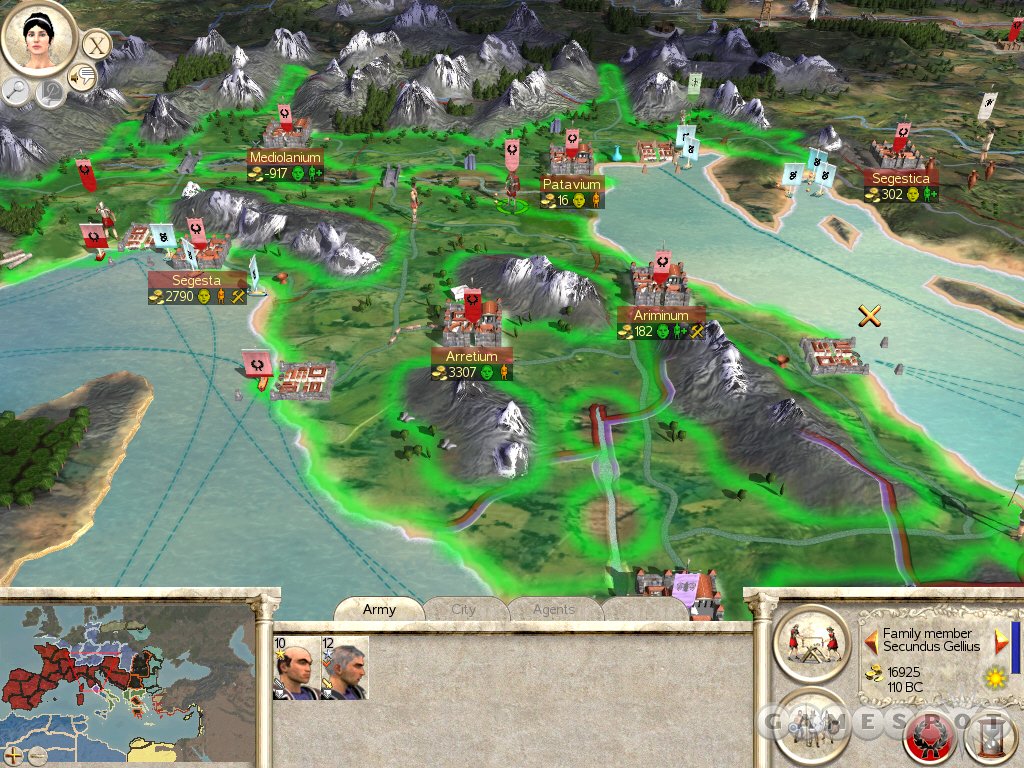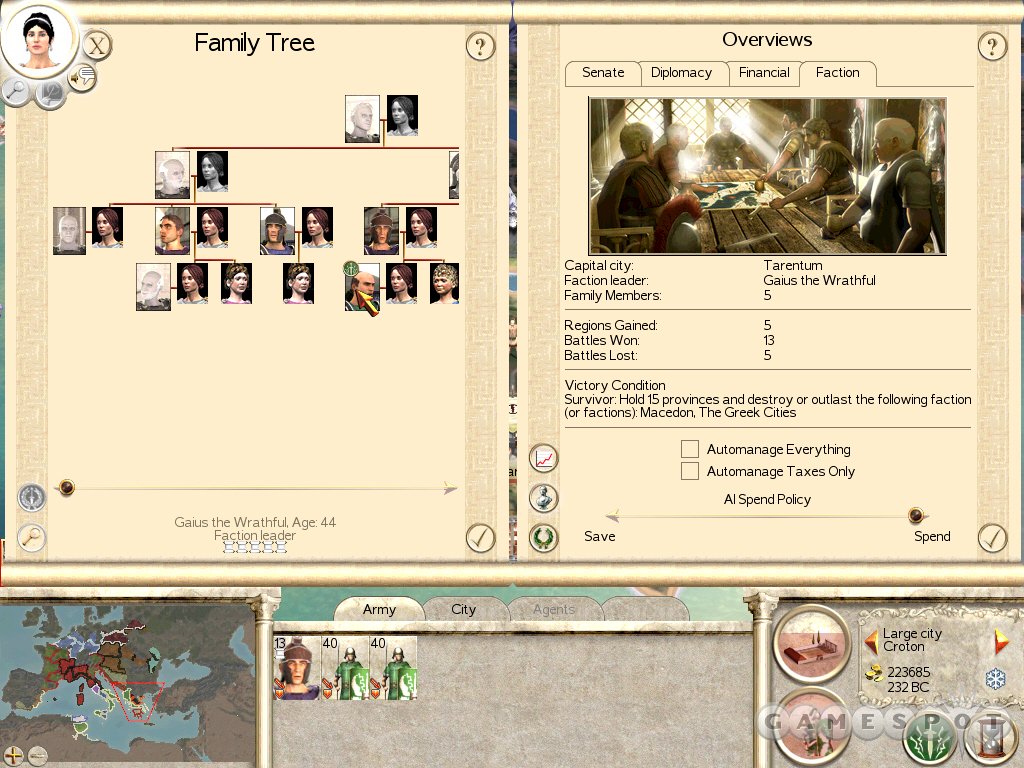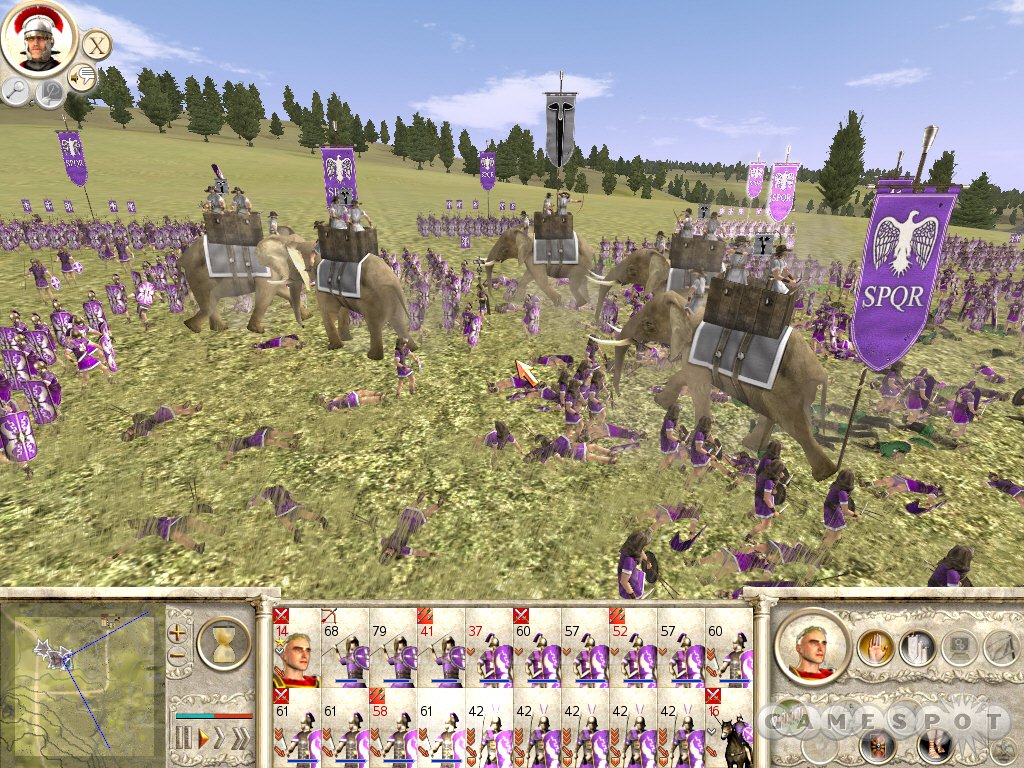Rome: Total War is the third Total War game from England's Creative Assembly, and, to make a long story short, it's the best one yet. It was naturally expected to build on its illustrious predecessors, which featured epic-scale real-time battles and impressive attention to historical realism and detail. Shogun: Total War was a promising start for the series, while Medieval: Total War built on that promise to create an even more engrossing strategy game. With Rome: Total War, Creative Assembly takes the next step, and it's as much a revolutionary step as it is an evolutionary one, thanks to a beautiful new 3D graphics engine that makes the series' tactical battles--featuring thousands of soldiers--better than ever. The results are nothing short of spectacular, helping make Rome: Total War the very definition of an epic strategy game.

As in the earlier Total War games, there are essentially two distinctly different types of gameplay in Rome. There's the overarching turn-based campaign in which you conquer cities and provinces, make improvements, and move armies around the map as you expand your empire, and then there are the real-time battles in which you use tactics and maneuvers to crush your enemy in combat. After the helpful and informative tutorial campaign, you can tackle the main imperial campaign. You play as one of three powerful Roman families--the Julii, the Bruti, or the Scipii--attempting to increase the size and glory of Rome and shore up your faction's power and influence. As all three factions are Roman, there's literally no difference between them in terms of units and building types, though they do have different responsibilities. The Julii must deal with the Gauls and Germania to the north in a difficult, landlocked campaign. The Bruti are required to deal with the remnants of the Greek city-states and expand the empire to the southeast. And the Scipii are tasked with subduing Carthage, Rome's great nemesis to the southwest.
At least, that's the principle goal of each faction. But there's a fourth, unplayable Roman faction, one that can influence your course during the campaign: the Roman senate. The senate will order you on missions, from blockading a hostile port or conquering a city (and perhaps exterminating the populace, depending on the level of enmity between Rome and the faction in question) to forging a trade deal or an alliance with a foreign faction. It's up to you whether you actually obey the order, as sometimes the senate will try to stretch you thin on purpose. If you carry the orders out successfully, you stand to gain a monetary reward, a useful new military unit, or influence in the senate. Failing to carry out missions earns the displeasure of the senate and affects your standing with that body. By and large, though, the senate missions help to focus the otherwise huge scope of the campaign--instead of being faced with the monolithic task of trying to conquer Europe, you can instead look forward to accomplishing a long series of short-term goals.
It's helpful to perform senate missions because they can affect an improved feature in Rome: Total War--families. Each of the three Roman factions is essentially one huge family, and your generals and governors are related to one another by birth, marriage, or adoption. These are the leaders of your faction, and they all have traits--strengths and weaknesses--that define their abilities. A strong general may have an excellent command rating, but his disdain for bureaucracy would make him a poor governor. Meanwhile, an otherwise strong governor may have a dislike of farming, which would affect the agricultural output in the province he's in. But if your family members are selected to hold important senate posts, they'll gain influence and abilities once out of office. This introduces a limited role-playing component in the game, as you actually care about trying to further the careers of your family members so they can serve you better.
In addition to traits, family members--not to mention your spies, assassins, and diplomats--can all attract retinues. These are the hangers-on who surround important people, such as advisors, mentors, bodyguards, lackeys, sycophants, and more. Each of these can affect your characters' abilities. For example, a wrestler can improve a character's influence (by being able to literally twist arms), as well as provide added protection against an assassination attempt. You can actually collect and trade retinue members among your family, so you can transfer them to where they're needed the most.

Families are also critical because only family members can serve as generals. You can assemble armies without a general, but they'll be poorly led and will likely fare badly in battle. But with a general, the army's fortune can change. A general with a high command ability is a powerful force in battle, as a well-led smaller force can defeat a poorly led larger force most of the time. On the other hand, the fact that generals are drawn from the ruling family can be dangerous, because you need to make sure there are future generations of leaders and generals. A disastrous battle can wipe out whole branches of the family tree, cutting down promising young sons before they can sire heirs. This can have a crippling effect later on in the campaign, when you find yourself short of qualified generals and governors with a huge empire to manage. It makes for an excellent incentive to try and preserve your generals, rather than treat them as easily replaceable fodder.
Thankfully, when you're short of governors, your cities will be taken over by the "automanager," which is represented by an appointed official who runs the city in your name. You can give the automanager certain priorities, such as to follow a military or financial policy, and it will go about constructing the building and units required. (You can also turn on the automanage functionality in cities that do have governors, if you don't want to micromanage at all.) The computer is generally good at doing what you tell it to do, and this should appeal to players who don't want to spend a lot of time on the campaign map. But if you're a fan of grand strategy and want to control every detail, you'll want to make sure you have plenty of family members at your disposal.

When you're not busy trying to crush your opponents, you can try to spy on, trade with, and subvert them. The diplomacy system has been completely overhauled since Medieval: Total War, and you now have a lot more options at your command. These include forming alliances, bullying your neighbors into becoming protectorates of Rome, and bargaining for trade rights. You can also dispatch spies and assassins to probe for weaknesses in enemy defenses, or to take out a key enemy general before a crucial battle. And in a nice twist, you can plant spies in your own cities, where they'll help keep unrest in check by acting as a secret police of sorts, rooting out the troublemakers.
The early to middle part of a campaign game can be quite tough, as you'll be hard-pressed on many fronts without a lot of resources at your disposal. In one particularly brutal game, our Julii faction found itself waging battles with Carthage, Spain, and the Gauls on three fronts. However, if you survive and defeat your enemies, you'll eventually have enough resources and momentum to deal with most other threats. The next big challenge occurs when civil war breaks out and you must march on Rome and defeat your rival Roman factions for control of the empire. This late-game development is particularly challenging, as all the core Roman cities have grown to massive size, and their close proximity to one another makes it easy for factions to throw advanced units at one another.
The imperial campaign runs from the early days of the republic to the peak of its power, a period covering approximately 270 years. Given that each turn represents six months--there are summer and winter turns--this means a campaign game can last more than 500 turns. That's surely an epic-scale length, and a campaign can easily consume days, if not weeks, if you decide to play out all the battles. There's also a smaller campaign that only requires your faction to conquer 15 provinces and eliminate your principal rival or rivals. And in addition to being able to play as the three different Roman factions, you can also tackle the campaign game as a foreign faction, such as Carthage, Britannia, or the Gauls. The only prerequisite is that you must crush the faction in question during a campaign in order to unlock it as a playable side. This is a bit annoying, as you'll probably have to play several campaign games to unlock all the playable factions. But these factions are worth unlocking, because they have access to unique units in the game, including chariots, elephants, and axemen. Also, not every faction in the game is playable, so be careful not to get your hopes up.
The campaign itself takes place on a beautiful 3D map that depicts a living, breathing world. Tiny caravans travel the roads and highways, while ships ply the trade routes between ports. During the winter turns, snow covers most of Europe, and that has an effect on units moving and battling in those conditions. But, most importantly, the new map is easy to read and is a big improvement on the board-game-like maps found in earlier Total War games. There are terrain features such as valleys and rivers that serve as natural strategic choke points on the map, and you can place armies in those positions to block them, thereby protecting your cities from sieges. You can also hide armies in forests, which allows them to ambush passing units, to devastating effect.

Ultimately, the turn-based portion of Rome is an excellent strategic game by itself. Its only flaw is the relatively weak naval combat. Unlike the land battles, you can only autogenerate the results of naval battles--you can't control them or even watch them play out. The results are a bit unpredictable, as you're guaranteed a win only if you have overwhelming numbers on your side. This makes sense, since a battle between two comparable fleets should theoretically be a toss-up, but you'll still feel somewhat helpless at not being able to jump into the battle and help turn the tide in your favor. Furthermore, the results of naval battles are often reported incorrectly--the number of ships reported sunk usually doesn't match up with the number of ships that actually remain. And in certain circumstances, it's possible to get a fleet permanently stuck in position, rendering it useless and a drain on your resources, though we rarely encountered this bug. So the naval battles in Rome: Total War are underwhelming. However, the terrestrial battles most certainly are not.
Of course, the turn-based campaign is only half the story in Rome: Total War, as the most anticipated new feature in the game is the 3D real-time battle engine. The transition from the 2D sprites found in earlier Total War games to Rome's 3D units has an almost revolutionary effect on the battles, as the action comes to life like never before. It's simply amazing to watch battles unfold and to see thousands of soldiers trying to kill each other. Though there a few awkward moments--such as seeing your men scramble around a single soldier they're trying to kill--the carnage is generally well animated and occasionally over the top. You'll see elephants hurl soldiers 30 or 40 feet in the air at times, or see guys fly 20 or more feet after being hit by a cavalry charge. Yet there are countless moments when you can simply zoom in and watch as individual soldiers try to slash and spear each other to death in moments that are reminiscent of the huge battles in recent Hollywood movies.

The 3D engine also has an almost transformative effect on the way you fight battles, as it's a lot easier to comprehend the flow of the fight. It's also easier to differentiate between good and bad tactics, even if you're a novice. If you see the Greek spearmen lower their long spears in formation, you'll intuitively recognize that a frontal cavalry charge against that would be ill advised. But if you can keep the spearmen distracted while you send your cavalry around to their flanks or rear, you can watch your horsemen slice through the Greek lines like a hot knife through butter. You'll also notice that your troops gain experience over time, so it's worth trying to preserve them. After a battle, you can send your units to a city where they can retrain. Doing so will not only restore them to full strength (though a veteran unit may lose experience if it absorbs a lot of new recruits), but it will also upgrade their weapons and armor, making them even more lethal in battle, assuming you've built the improvements necessary to do so at that city.
You'll need a perfect storm of events in order to witness the largest battles possible, so most battles skew toward the smaller scale, with only a couple of thousand troops on the battlefield. These smaller battles still look amazing, and they are easier to manage, as you have fewer troops to worry about. You can pause the action and issue orders at any time, which is extremely helpful, though you don't have that option during a multiplayer game. At the highest detail settings, some of the largest battles and sieges can cause the action to stutter, but even at the lower detail settings the game still looks spectacular. The camera controls take a bit of getting used to at first, but you'll eventually get the hang of it. About the only flaw that we can find in the graphics is that it occasionally feels like you're watching clones on the battlefield, as all the soldiers in a unit look exactly alike. It would have been nice to have seen a little variation in the troops, but most of the time the action onscreen is so hectic you won't notice anyway.
The sound and music during battle also deserve some recognition, since they complement the visuals on the screen very well. When you issue a march order, you hear the stomping of hundreds of boots on the ground and the music changes to a fitting march theme. When battle erupts, the audio stands out, with the clang of steel on shields, the whoosh of spears and arrows in the air, and the cry of thundering elephants. Above it all, the music constantly shifts gears to fit the scene, much like the score to a motion picture. The driving tempo of the music helps sweep you up into the action.

In addition to the campaign game, Rome comes with some historical battles and a skirmish mode that you can play if you want to get straight into the action. Then there's the game's multiplayer suite, which is limited to battles. There are essentially two multiplayer modes: a fast-paced skirmish game and a slower, more tension-filled siege game. The straight skirmish mode tends to run a bit quickly, due to the fact that all the contestants start in the open and it doesn't take long before a faction is wiped out. A good cavalry charge at the beginning can usually settle the battle by crippling one side. Meanwhile, siege battles can be great fun, as they're almost chesslike in that the attackers must probe for a weakness in the city's defenses while the defenders react to them. Rome's multiplayer browser makes it fairly easy to find a server, though the overall interface could have used a bit more work. In particular, there ought to be a time limit when deploying forces, as it can be annoying having to wait while a micromanager tweaks the starting position of every single unit.
But issues like these are easy to overlook when you consider the big picture. Ultimately, this is a deeply satisfying strategy game that can appeal to game players of all types. If you're looking for a complex, addictive, conquer-the-world campaign, you can look forward to the imperial campaign, which is good for countless hours of gameplay all on its own. Meanwhile, if what you want are realistic, cinematic-style battles, you can dive into the historical battles or the skirmish or multiplayer modes, or have the computer manage all the details in the campaign and just join the battles. And if you're looking for both, then you'll probably find Rome: Total War to be perfectly sublime blend of the two.